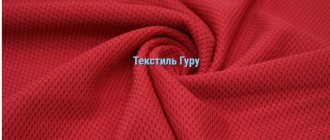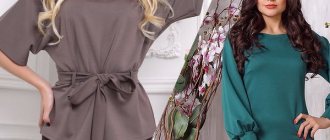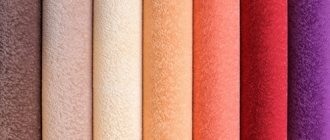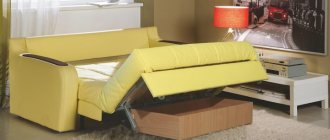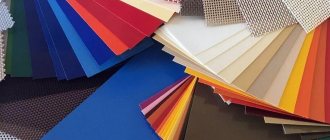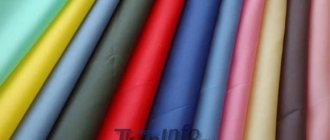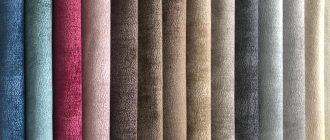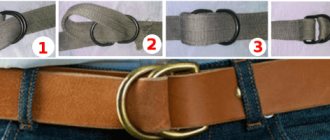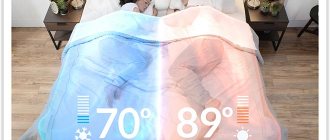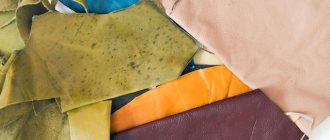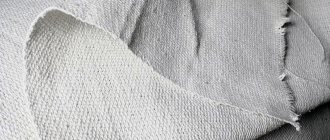In the modern clothing industry, synthetic fleece knitwear plays a significant role. This invention of American manufacturers is just over 35 years old, but it has already gained popularity and spread throughout the world; a large number of different products for the home have begun to be made from it. In this article we will take a closer look at fleece fabric in clothing and take a closer look at what it is: the composition of the material, properties, characteristics, and we will provide photos of its different types. Features of threads, their production. The word Fleece translated from English means sheep's wool, sheared from one sheep. The product is truly comparable in quality to natural fleece; it is, one might say, an artificial analogue of sheepskin. In terms of its parameters, it turned out to be a worthy alternative to a natural element, only less absorbent of water and more breathable. The authorship belongs to the company Malden Mills, which began experimenting with polyester to make a plastic substitute for the warmest natural structure. A team of engineers managed to create a dense fabric from tiny polyester threads. Outwardly, it resembled terry cloth, only it turned out to be lighter. After combing it, the volume of the pile increased significantly, and it was found that the fabric did not absorb moisture.
Subsequently, the invention went through many stages of improvement. The result is a product that has the best characteristics of wool, but is devoid of its disadvantages. In comparison with its synthetic analogue:
- does not absorb moisture;
- does not have any repulsive odors;
- does not deform when dried;
- is light;
- does not cause allergic reactions.
In 2007, Malden Mills reorganized and was succeeded by Polartec, LLC.
At the moment, more than 300 types of products are produced under the name of this brand. Polar Fleece is supplied to Russia mainly from China and the USA. High quality distinguishes the products of Eddie bauer, North face, Patagonia, Lands end, Llbean corporations, which is confirmed by their many years of practice.
Domestic production is also largely represented by structures that came to the Russian market from abroad. In particular, a company specializing in ski equipment, Stayer. The company offers a wide range of products intended for winter sports.
Manufacturing features, properties
Let's look at what fleece fabric is and what it is made from.
At the first stage, the finest threads are obtained from polyethylene terephthalate (PET) fibers, and then they are tied into a dense polyester base. Next, the resulting web is driven through the brush plane. On equipment with brushes, loops are pulled out of it, creating a kind of pile on the surface. The result is a fluffy pile from these polymer nodules, in which many air pores are formed. The material noticeably increases in size without adding weight. A similar cushion of air and polymers gives it softness and heat protection.
The resulting product undergoes a special cleaning treatment, which ensures its ideal shape throughout the entire period of wear. The product is processed with various mixtures that reduce its flammability (when a fire is applied it begins to melt), impart water-repellent or other certain qualities.
How to choose fleece clothing?
To choose a fleece product that is suitable for your activity, you need to pay attention to the following:
- Density of fleece fabric. You need to choose clothes depending on the weather and season. For example, fleece with a thickness of 100-200 g/m2. It’s better to buy for spring or summer, but for winter you need to choose a thicker fleece;
- Models for spring, summer;
- Models for winter, autumn;
- Presence of lightning. This is convenient, for example, if it gets hot while walking and you have a large backpack on your shoulders, you can not take off the fleece, but unfasten it and continue moving;
- Pockets. You can put various small things in them: a phone, a map, a navigator. It’s even better if the pockets have fasteners;
- Pay attention to the elastic or lace at the bottom of the jacket, thanks to it you can tighten the jacket in strong winds;
- Layer in the shoulder area. The shoulder area is most often exposed to active mechanical stress when wearing backpacks and bags. A simple precaution will extend the life of your jacket.
- Cut. Tight-fitting or loose, depending on the type of activity. Here you also need to understand whether you are taking a thing to wear over something or under it. By the way, fleeces should not be worn on the naked body; you should wear a T-shirt or thermal underwear underneath. Men's models have a loose fit, women's models are more fitted.
- Finger slots. Comfortable and will help warm your hands.
- Hood. Protect your head from wind, light rain and snow. Helps keep you warm for as long as possible. Also pay attention to the drawstrings on the hood; in strong winds this will prevent it from flying off your head.
- Ventilated inserts. This will be useful for long and intense activity. If the material is too thick, the skin will not be ventilated and will begin to swell, which can cause irritation.
- Color. Products can be single-color or several colors. What to choose depends on your desire. The color range is varied.
- Children's models. Special models are sewn for children; even for a six-month-old child you can find a fleece blouse.
The modern market for tourist clothing is ready to offer the buyer options for every taste and for different requirements - with a zipper, with a hood and without it. The most popular brands are: Salewa, Mammut, Maier, Reima, Jack Wolfskin. They and many other manufacturers are fully represented in the Kant store catalog.
These companies not only produce high-quality, practical outdoor clothing, but also constantly improve their designs, expanding their capabilities and adapting them to the needs of lovers of active pastimes. A fleece jacket is a must-have for any tourist, athlete and traveler who values comfort and versatility. Such a thing fully justifies the money spent with its excellent performance characteristics.
Description, composition, types of fiber
To the question: “Is fleece synthetic or natural fabric?”, there can be only one answer - Fleece is a 100% artificial fabric, polyester knitwear.
It has a fluffy surface on both sides, pleasant and soft to the touch. Models are distinguished by density, processing method, structure and appearance.
The first indicator can be from 100 to 600 grams per square meter. The clogging of each loop with lint, softness and thermal insulation qualities depend on this. The cost of the product and its durability also directly depend on the filling method. Types of fleece:
- Models with the smallest thickness are called microfleece, which allows it to be used with this value only for sewing thin products: underwear, pajamas, etc.
- A little thicker - polar fleece, its features make it possible to sew jackets, light sweatshirts, and thermal underwear from it.
- The most popular is medium-density fabric (from 200 g/m2). It is used to make children's clothes, hats, scarves, and mittens.
- More solid items are created from knitwear of higher than medium density: winter clothes, home textiles.
- The thickest fabric is used for sewing tourist and mountaineering gear and equipment. This is the high-quality material that Stayer uses.
Currently, products are subjected to a whole range of processing procedures.
They can be produced on one or both sides. Manufacturers add additional elements to the composition, which gives it modern quality characteristics and new names:
- add Lycra - to enhance wear resistance, spandex - for elasticity (suitable for making gloves);
- they make a two-layer product: the top layer protects from wind and rain, the inner layer insulates;
- They produce a version with improved protective parameters, with an intermediate membrane layer between 2 rows of Polar Fleece - windblock.
Consumers often have a question: is fleece warm or not? As we have already noted, there are miniature air bubbles inside the pile, which successfully serve as a reliable heat insulator. The thicker the polymer structure, the more oxygen in the pores and the warmer the clothing will be. Airiness gives lightness to the material, allows it to be compressed and easily packed.
History of fabric
Fleece production began at the end of the 20th century. The technology was invented by the American company Malden Mills as a result of numerous experiments to create light, warm, breathable sportswear. The developers of the material later received the Nobel Prize in Chemistry for their discovery. The company's reluctance to patent the invention contributed to the spread of the new fabric: analogues of the original began to appear everywhere at attractive prices.
The first collection of fleece sweaters and trousers was released in 1981 by the SYNCHILLA trademark, a leader in sales of high-quality sports equipment.
Advantages and disadvantages
The combination of fleece properties is truly unique. Its advantages include:
- low specific gravity of products;
- breathability - the air freely penetrates through the fabric, the skin breathes, it is difficult to sweat in a fleece garment;
- waterproof - the product does not absorb water and dries quickly;
- sufficient heat protection and thermoregulation: a jacket or cardigan made from it is capable of maintaining a favorable temperature, which prevents it from freezing or sweating;
- washing machine permissibility;
- preservation of heat-protective characteristics in a wet state;
- sufficient wear resistance and abrasion resistance;
- easy to care for: fleece items are easy to wash, no need to iron;
- no allergic reactions to knitwear;
- elasticity: clothes do not interfere with movement, and at the same time do not change the original shape.
Fleece can be exposed to the sun, moisture, and frost for a long time without losing its original qualities.
The appearance of the products is perfectly preserved even after many washes. The disadvantages include:
- the ability to accumulate static electricity and be subject to electrification;
- the ability to collect dust;
- highly flammable unless appropriate treatment is carried out.
Advantages
Polar fleece has the following advantages:
- the material is light, despite its volume and density;
- Excellent air permeability, allowing the body to breathe;
- wicks moisture away from the body well;
- waterproof;
- excellent thermal protection, retains heat even in a damp state;
- elasticity, strength, abrasion resistance;
- things dry quickly after washing.
The fabric does not cause irritation to people with sensitive skin and is suitable for sewing children's clothing. In addition, the clothing is resistant to prolonged exposure to sun, rain and frost.
Application for the production of workwear
Thick types are produced for sewing insulated workwear. It is applicable to people working outdoors in cold air. The material is used to make work trousers, clothing for those who like fishing and hunting, and camouflage uniforms. It is hemmed as lining into work overalls, mittens, and hats.
Taslan
Taslan is a synthetic fabric based on nylon (polyamide) fibers with rep weaving and waterproof impregnation. Taslan is widely used for sewing outerwear due to its strength, high protective properties, and resistance to dirt.
Taslan consists of nylon with a porous coating applied on the reverse side, which acts as a membrane. In some types of taslan, special reinforcing fibers can be used to further increase strength. This fabric is of the rip-stop type, which prevents the spread of tears.
There are several types of internal taslan impregnations, determined by the use of the fabric. For clothes with insulating fillers, a white polymer layer is used. Polyurethane impregnation can be applied both outside and inside. This impregnation is designed to protect against moisture. Water-repellent impregnation WR literally collects water in drops and does not allow it to linger on the surface of the fabric.
The main advantages of taslan
- lightness, strength
- wear resistance
- breathability
- waterproof
- protection against pollution
- It does not require special care.
Application area
Most often, taslan is used for the outer protective covering of winter or demi-season clothing: jackets, suits, overalls and insulated trousers. Taslan is especially often used to make sports, tourist, household and work clothes. Non-marking, lightweight, durable taslan is perfect for the harshest conditions.
How to care for clothes made from taslan
Taslan does not require special care. If the fabric gets dirty, most often it is enough to wipe it with a damp cloth. Taslan can only be washed with liquid detergents so as not to damage the membrane layer. Both hand and machine washable. Do not use bleaches or active cleaning agents! Dry cleaning is not allowed!
Taslan needs to be dried naturally; it dries quickly. You should not iron clothes: this is not necessary, and the high temperatures of the iron can damage protective coatings.
Use in other areas
The product in question makes good jackets and sweaters, usually for sports or tourism purposes.
They are worn over thermal underwear, and on top is a piece of breathable fabric with a membrane. Fleece products are great for active sports. There is always an air gap in the pile, and it is an excellent thermal insulator. Equipment for athletes from various versions of Polar creates the necessary internal ventilation when overheating and removes condensation outside. An example of this is a warm jacket in which you can ski, even high in the mountains. You can find out what a “fleece” is and buy this product in the Stayer online store. You can view the range of similar products on the company’s official website.
But one condition must be observed. For the properties of the material to work, the above clothing must be worn over thermal underwear. If you use a cotton T-shirt, it will quickly become wet, and the full effect of using the polymer will be lost.
Fleece, by its characteristics, is literally created for children's clothing. It not only provides the child with comfort and warmth, but also lasts a long time, always looks good, and is suitable for all babies from birth. In winter, a base layer is often added for the jacket.
What is a fleece lining? This is a soft insulation for hats, jackets, and mittens.
Products in the manufacture of which this fabric is used:
- Pajamas and home suits are made from the finest material.
- Linings, warm sweaters and overalls are made from slightly denser fabric.
- Jackets for children and teenagers are made from a particularly durable type.
- It has become widespread when products for children are lined with fleece, which is convenient, and most importantly, it is practical for children, both for hiking and for everyday wear in winter.
The material is able to retain rich, bright colors, which consumers like.
Reviews
Reviews about polo fleece fabric are extremely positive. Here are some of them.
Faith. As a mother of 3 children, it is important to me that clothes are not only beautiful, but also practical. I bought my youngest child an autumn onesie made of half fleece. I am completely satisfied with the properties of the material. A huge plus is that the overalls are warm, but the child does not sweat in it.
Igor. I am an avid fisherman, so spending the night in a tent is a common occurrence for me. My favorite blanket is made of half fleece. It warms well, does not prick, and helps out even when the weather gets worse.
Nuances of care
One of the advantages of Fleece is its ease of use.
It washes well, dries instantly, and does not require subsequent ironing.
However, its synthetic composition requires compliance with some simple conditions:
- Polyester fabrics can be washed at a water temperature of no higher than 40 degrees; if you use a machine method, then on a gentle cycle, without intense exposure. It is strictly not recommended to twist or spin at high speeds; the item may lose its shape.
- It is better to hang the product on hangers so that the moisture runs off, and then dry it on a towel. Do not dry on hot radiators, heaters, or over an open fire.
- Ironing is also not allowed, since at 60 degrees the polymer begins to break down and melt.
- There is no need to use washing powders. It is safer to use the liquid form. After using detergents, it is recommended to rinse thoroughly.
In short, the unique qualities of fleece, as a modern and practical material, are increasingly used in the manufacture of sports, tourism, children's and casual clothing.
It is becoming in demand among consumers of different ages and needs. The product is being improved, new modifications and additions to the main fabric appear. When choosing products, it is important to pay attention to the manufacturer; it is better to contact those who have already established themselves in the market. Among the manufacturers of products for alpine skiing, snowboarding and long walks in the cold season, Stayer has established itself as a company that produces stylish items at a low price. In the article, we talked about the features of the material, explained what polar fleece and microfleece are, as well as how to use this fabric.
Appearance of material
Polarfleece is a trademark of the original fabric developed by Polartec LLC. The company was founded by Hungarian emigrant Henry Forstein in the city of Malden (USA) in 1906. Then it was called Malden Mills, which can be translated as Malden workshops. In the 1970s, amid public campaigns against the killing of animals, the company produced artificial fur for clothing. The result of the development was the emergence of a fundamentally new fabric made from synthetic fibers - polarfleece. She managed to oust wool from production, not a name that became the personification of her main development.
Marking examples
For clarity, here are some typical examples of Oxford fabric markings.
- PU is a product impregnated with polyurethane.
- PVC - PVC coated fabric.
- 300 d PVC PU - means that the material is impregnated with a hybrid composition of polyvinyl chloride and polyurethane. It is used when they want to improve the characteristics of the fabric - remove electrostaticity, increase thermal insulation properties, and ensure resistance to fire and chemicals.
- RS (rip-stop) is a fabric with a special weave: a thickened thread is woven into the main body of fabric, which increases tensile strength.
If Oxford made from natural cotton was used when sewing clothes, you will find the label “100% cotton”.
